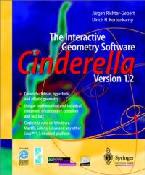The Interactive Geometry Software - 'Cinderella' Version 1.2

Cinderella
by Jürgen Richter-Gebert and Ulrich H. Kortenkamp
The very fetching purple and yellow packaging states that this is "the" interactive geometry software. A little optimistic, perhaps; The Geometer's Sketchpad and Cabri both have their - not insubstantial - followings. And the previous release of Cinderella gave the impression of a terribly well-featured package lacking slickness. But therein lies the value of Version 1.2: slickness.
Cinderella is interactive geometry software - which, if you were wondering, means that it presents us with a digital blank slate and a set of tools for doing all sorts of exciting things, like drawing points, lines, circles, perpendiculars, bisectors, loci, and so forth. All the classical constructions possible with compasses and straight-edge are provided for, as are the new-fangled facilities of ruler and protractor. It is much more thrilling than it sounds, I promise, and a blessing for those of us who regularly need to make digital illustrations for pieces of mathematics.
For example: suppose that I want to illustrate the idea of an orthocentre (the intersection of altitudes of a triangle). All I must do is to define three points A, B, C, add the three lines connecting them and the three perpendiculars to these lines through A, B and C. I label the intersection of perpendiculars, H. This is achieved in Cinderella with a couple of dozen clicks. The
result looks like this:
If one of the original points is moved, the construction redraws itself, as you can see. One of the great gripes about the previous version of Cinderella was that with more complicated constructions, particularly those involving loci, there could be a wait of several seconds while the construction was updated. Often gaps would appear in curves, points would jump discontinuously, and occasionally the program would crash.
Nowhere is it made clear what the differences are between Cinderella and Cinderella 1.2; I don't see any new features (though the original package was crammed with good things anyway) - but it seems that the mathematical basis for the program has been reworked, making the behaviour of even fiendishly complicated constructions smooth, reliable, and much faster. The interface remains the same: intuitive for most, but clunky for some.
Space does not permit me to enthuse about Cinderella's facilities for designing exercises, for switching between Euclidean, spherical and hyperbolic geometries, and for making animated drawings - each of which is too thrilling for words. The manual covering all this versatility is mercifully slim, devoting a succinct page to each feature. Though occasionally gushy ("There is no limit to creativity but correctness!"), clarity doesn't seem to have suffered in the translation from German.
At $54.95, those who already use Cinderella regularly may well find that the increase in speed and accuracy justifies an upgrade. For a new user who needs a tool for understanding and visualising geometry, these improvements make the package a convincing first choice.
- Details:
- Cinderella 1.2
- Jürgen Richter-Gebert & Ulrich H. Kortenkamp
- manual 138pp
- ISBN 0-88385-530-5
- Springer
- System Requirements:
- Java-1.1 compatible platform
- 800×600 True Color Graphics
- 32MB RAM or more
- 133 MHz CPU or higher
- Website: www.cinderella.de